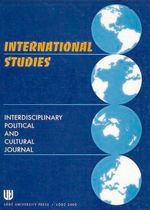RUSSIAN-ESTONIAN RELATIONS AFTER 2007: CURRENT
STATUS AND DEVELOPMENT PROSPECTS
RUSSIAN-ESTONIAN RELATIONS AFTER 2007: CURRENT
STATUS AND DEVELOPMENT PROSPECTS
Author(s): Agata WłodarskaSubject(s): Politics / Political Sciences, Geopolitics
Published by: Wydawnictwo Uniwersytetu Łódzkiego
Keywords: Russian – Estonian relations; Bronze Soldier Night; cyber attacks in Estonia; The Estonian State Integration Programme; Russians in Estonia
Summary/Abstract: The article highlights the major points that have influenced relations between Russia and Estonia after 2007. These relations were rather poor during the post-Soviet period. The number of Russian people who lived in Estonia after gaining independence in 1991 exceeded 30%, which resulted in the very keen interest of Russia in Estonian politics. April 2007 created a new reality for relations between the countries. The decision to move the statues of Second World War Soviet soldiers from main squares to cemeteries provoked negative reactions from Russians living in Estonia, but also infuriated leaders of the Russian government. As a consequence there were harsh verbal attacks from Moscow, the Estonian ambassador to Moscow was harassed, cyberspace attacks took place and traffic over the bridge in Narva, which is a key highway from Russia,was blocked. The Estonian authorities know there is no point in maintaining conflict with Russia. The President of Estonia, Toomas Hendrik Ilves, has stressed that Estonia’s relationship with its biggest neighbour, Russia, can only get better. Russia plays an incredibly important role in the Estonian economy and tourist industry, according to Andrus Ansip, the Prime Minister of Estonia.
Journal: International Studies: Interdisciplinary Political and Cultural Journal (IS)
- Issue Year: 13/2011
- Issue No: 1
- Page Range: 40-47
- Page Count: 8
- Language: English

